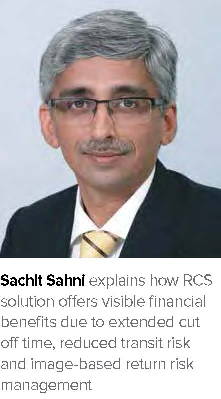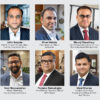The Royal Bank of Scotland has launched a new digital cheque collection solution that shortens the time for cheque collection and processing. Given the geographical breadth of India, this new innovation will provide significant benefits for corporate and non bank financial institutions (NBFIs):
The Royal Bank of Scotland has developed a solution, Remote Cheque Scanning (RCS), which is an image-based cheque clearing system that has cut down transit time and clearance time of cheque processing. This is one of the recent innovations that the bank has brought to India for the convenience of its corporate and NBFI customers.
“Corporates in sectors such as insurance, telecom, media, power distribution, retail and NBFC face the prospect of delayed collection and realization of their receivables, more so as they increasingly expand their operations to tier 2 and tier 3 cities,” says Sachit Sahni, head – Transaction Services, India for RBS. “This naturally leads to cash flow delays for them. It is against this background that we decided to develop a solution to streamline and fast-track the collection and realization process. Given our deep understanding of this challenge, and our capabilities in innovating new and out-of-the-box solutions, we have managed to design and develop this solution in record time,” he adds.
RCS makes optimum use of imaging technology and works in conjunction with the Cheque Truncation and Speed Clearing Systems introduced by the Reserve Bank of India (RBI). This solution helps corporates to reduce the time taken for realization of funds and, in turn, improves their working capital cycle. Corporates in the insurance and telecom sectors, with substantial cheque collections from multiple cities, are able to significantly benefit by using the RBS’ platform. The system enables funds to be collected within 1-3 day time period, as against the 2-14 days (on an average, depending on clearing and pick up location) typically involved in the physical mode of collection. Corporates also benefit from the extended clearing cut-off times across all locations because of image-based clearing, further helping them in realization of funds in a short period of time and eliminating the settlement risk.
Pain Point
 Sahni says RBS Transaction Services business in India has strong capabilities and expertise in cash management and trade finance services. “The vast geographical spread of India makes cheque collection and realization a time-consuming and challenging task, not just for the corporate customers but also for banks such as ours. RCS offers significant operational efficiency, and helps cut down on operating and credit risks. The solution offers visible financial benefits due to extended cut off time, reduced transit risk, image-based return risk management and single MIS and reconciliation across all locations,” Sahni says.
Sahni says RBS Transaction Services business in India has strong capabilities and expertise in cash management and trade finance services. “The vast geographical spread of India makes cheque collection and realization a time-consuming and challenging task, not just for the corporate customers but also for banks such as ours. RCS offers significant operational efficiency, and helps cut down on operating and credit risks. The solution offers visible financial benefits due to extended cut off time, reduced transit risk, image-based return risk management and single MIS and reconciliation across all locations,” Sahni says.
Solution
The RCS solution works in the following way: Images of cheques collected at various client locations or at network points are captured in the system. These images are then transmitted to a central server of the bank from where the same are sent to the clearing house. As soon as the clearance happens, RBS credits the accounts of the respective customers. The customer gets the key benefits of extended cut off times of 5 pm, reduced risk of losing the cheques in transit and local clearance for outstation cheques. The customers also get regular MIS in their format of choice, including an ERP uploadable format.
Four Models
The bank can deliver this solution through the following four options:
Outsourced Model, which is an outsourced cheque collection process. RBS representatives visit the various network points and collect the cheques at specified timelines and image the cheques to a centralized location through a secure channel for clearing.
Utility bulk model, where the cheque images are sent from the client’s office, to ensure large volumes are processed on the same day without incurring any transit delay.
Customer facing self-service kiosks, where end customers walk-in and deposit the cheques via the kiosks. These kiosks can be linked to RBS’s network via secure internet connection to ensure the digital image of the cheque is sent in real-time for processing. A deposit receipt is provided to the customers.
In-house kiosks at the client office locations, where volumes are not high, but locations are far from centralized processing hubs. Once the cheques are received from the customers, customers are able to deposit the same at the kiosk instantaneously.
In all the above models, the bank will validate the cheque images before sending these through for further processing over RBI’s Cheque Truncation System. The RCS solution has provisions to offer customized reports to the clients on the cheque information and clearing status. These reports are delivered back to client through the bank’s electronic banking platform.
Security
How is the cheque image transmitted to the bank’s server and how secure is the data transmitted?
Says Sahni: “The scanning site will transmit the data across a secured VPN network, which will then connect (via specific static IP) and transmit to the central server. The service provides secure data transmission with bi-directional encrypted. Authentication is mutual, unlike typical web applications in which only the server is authenticated by the client. Authentication is performed every time a new session is established. Encryption is mandated, so the server does not provide authentication without encryption, nor can it encrypt without authentication.”
The bank introduced the solution in India a little over a year ago and the response has been encouraging. “This is a system developed, specifically for the Indian market. We may at a later date think of introducing similar systems in other Asia-Pacific countries where cheque-based truncation systems are in vogue,” says he.
“What I would like to emphasize is that the RCS system is totally complementary to RBI’s CTS and the speed clearance system and it does not function independent of the RBI systems. RCS solution will help elevate the collections landscape to a new level in India,” Sahni concludes.







